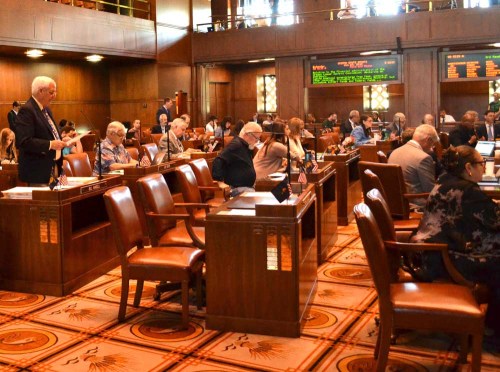State proposal to address homeless youth crisis
Published 6:00 am Tuesday, January 12, 2021

- State Sen. Bill Hansell, far left, speaks on the Oregon Senate floor on June 29, 2019. Hansell was one of six Senate Republicans who showed up to the floor on March 25, 2021, as the chamber took up a proposal to ban firearms in state buildings and lay the foundation for other bans.
SALEM — The Oregon Legislature is set to deliberate on a new bill aimed at addressing the state’s homeless youth crisis.
The draft bill, Legislative Concept 2625, would allocate $4.4 million in taxpayer funds to the Department of Human Services, which would be charged with using the money to expand youth shelter facilities and fund “host homes” across the state.
Trending
The bill has the support of at least one Eastern Oregon GOP legislator — Sen. Bill Hansell of Athena.
“I think that one of the things that government is to do is to provide assistance to those who need it,” he said. “We’re seeing an increase in the homeless youth for whatever reason, but not only that — I’ve been told that Oregon has the highest number of homeless youth in the nation.”
In fact, Oregon is tied for the highest percentage of homeless youths in the United States alongside Alaska, Nevada, Washington, California and the District of Columbia, according to a wallethub study. That study also placed Oregon among the states with the highest percentage of homeless youth drug users.
The number of youths who can be classified as homeless in Oregon has been shown to jump during periods of economic hardship. The Ecumenical Ministries of Oregon, which has lobbied the Oregon Legislature in support of the bill, claim the number of homeless youths in Oregon jumped by 32% during the 2008 recession.
The COVID-19 pandemic also has exacerbated the homeless crisis. State tracking of homeless youth under the McKinney-Vento Act found 80 students at La Grande School District were unsheltered during the 2019-20 school year, up from 40 the previous year.
“We’re expecting to see a big increase in the coming years,” said Olivia Asato, a public policy associate with the Ecumenical Ministries of Oregon. “The impact will continue on beyond this year. A lot of the numbers (for this year) have gone down, and that’s just due to distance learning. Homeless students become hard to identify when you’re doing virtual learning, especially when they’re unaccompanied.”
Trending
While Oregon’s homeless youth crisis is measurably severe, debate remains over why. Hansell attributed the situation to a breakdown of a more traditional family structure.
“I think a lot of it has to do with the breakdown of the nuclear family,” he said. “What used to be the norm doesn’t seem to be the norm anymore, with the kind of structure that homes had. I’m not saying we were ever perfect, I’m not saying we were ever where we should be or we didn’t have problems, but I think that with the rise of things that aren’t necessarily good for society … those types of things and those types of behaviors aren’t good, I don’t think, for the family structure.”
Hansell said those types of behaviors include an over-embracing of drug use and substance abuse.
Asato, however, said youths in Oregon are often pushed into homelessness for four main reasons: economic insecurity, domestic violence, substance abuse by adults in the household and failure to support LGBTQ+ youth.
“We think it’s really important to identify these (causes) to dissuade stereotypes that homeless youth just don’t want to follow the rules of their household and things like that,” Asato said.
LC 2625 likely will change before it reaches Hansell in the Oregon Senate, as it’s set to be introduced in the House of Representatives first. That may be for the best, as Asato said the $4.4 million in host home and shelter funding won’t be enough to solve the homeless youth crisis.
“This isn’t a high enough number,” Asato said. “In an ideal world, more money would be invested, but you know, it’s a budget cut year in a pandemic.”
Regardless, Hansell said the Legislature needs to deal with homeless youths sooner rather than later.
“It’s an issue that I think we need to address,” Hansell said.









